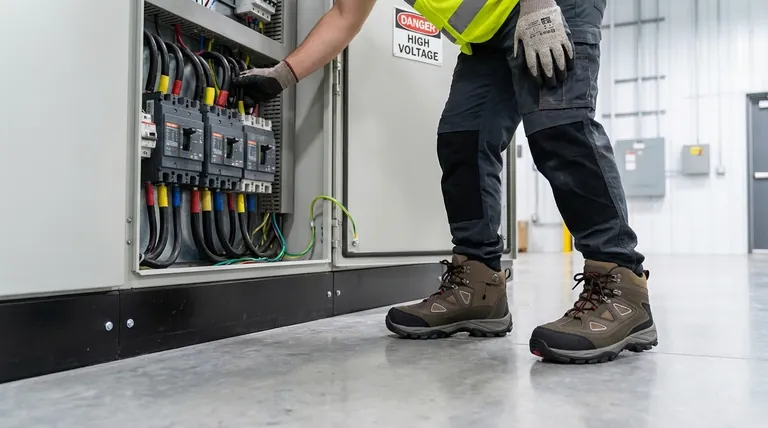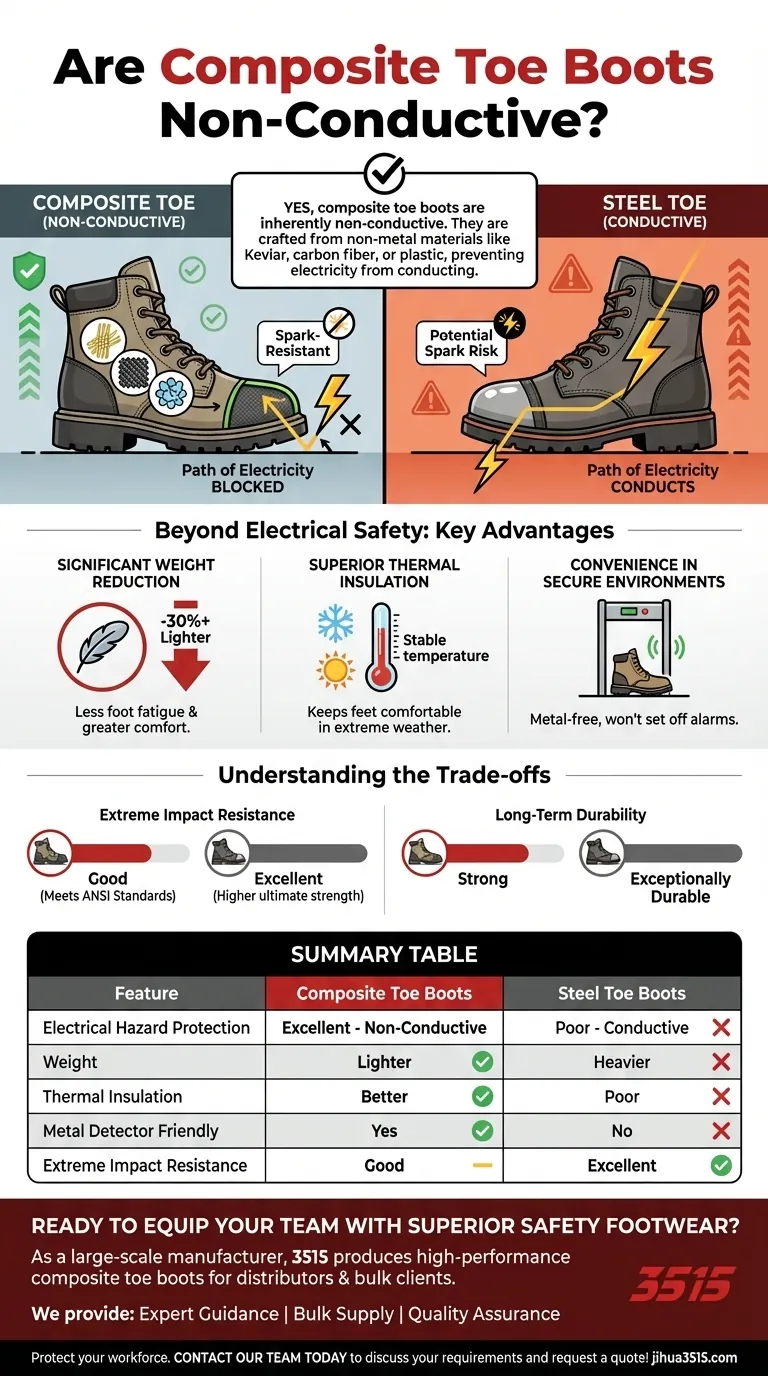Yes, composite toe boots are inherently non-conductive. Because they are crafted from non-metal materials like Kevlar, carbon fiber, or plastic, they do not conduct electricity. This makes them a fundamentally safer choice than steel toe boots for anyone working in environments with potential electrical hazards.
The core takeaway is that while composite toe caps provide excellent electrical hazard protection, this benefit is part of a larger trade-off. Your choice between composite and steel depends on whether your primary risk is electrical shock, extreme impact, or environmental exposure.

Why Composite Materials Are Non-Conductive
The primary safety feature of a composite toe boot in an electrical environment comes down to its material composition. It's a simple matter of physics.
The Absence of Metal
Composite toe caps are made from a blend of non-metal materials, which can include Kevlar, carbon fiber, plastic, or fiberglass.
Unlike steel, these materials are poor conductors of electricity. This inherent property is what provides the protection.
The Safety Advantage
This non-conductive nature prevents the boot from creating a path for an electrical current to travel through your body to the ground.
This also means composite toe boots are spark-resistant, a critical feature in volatile environments where a single spark could be catastrophic.
Beyond Electrical Safety: Key Advantages
While non-conductivity is a defining feature, composite toe boots offer several other practical benefits that contribute to comfort and safety.
Significant Weight Reduction
Composite materials are significantly lighter than steel, often reducing the boot's weight by 30% or more.
Over a long workday, this reduction in weight leads to less foot fatigue and greater overall comfort.
Superior Thermal Insulation
Metal is an excellent conductor of temperature, but composite materials are not.
This means composite boots do not get as cold in the winter or as hot in the summer, providing better thermal insulation and keeping your feet more comfortable in extreme weather.
Convenience in Secure Environments
Because they are completely metal-free, composite toe boots will not set off metal detectors. This is a major convenience for workers who must frequently pass through security checkpoints.
Understanding the Trade-offs
No safety product is perfect for every situation. Choosing composite toe boots involves acknowledging a few critical trade-offs compared to their steel counterparts.
Impact Resistance vs. Steel
Both composite and steel toe boots must meet the same ANSI/ASTM safety standards for impact and compression resistance.
However, in cases of extreme impact from exceptionally heavy falling or crushing objects, steel can often withstand a greater single impact without cracking. Composite materials, while strong, may have a lower ultimate failure point.
Long-Term Durability
Steel is an exceptionally durable material. Some evidence suggests that over a long period of heavy use, the composite material in a toe cap may wear down or degrade slightly faster than a steel cap would.
Making the Right Choice for Your Environment
Your specific job site and its primary hazards should always guide your decision.
- If your primary focus is electrical hazard protection: A composite toe boot is the clear and superior choice for its non-conductive properties.
- If your primary focus is protection from extreme crushing weight: A steel toe boot may offer a higher margin of safety against the most severe impacts.
- If your primary focus is all-day comfort, and temperature regulation: A composite toe boot provides a significant advantage due to its lighter weight and thermal insulation.
Understanding these core differences empowers you to select the safety footwear that truly matches your specific workplace demands.
Summary Table:
| Feature | Composite Toe Boots | Steel Toe Boots |
|---|---|---|
| Electrical Hazard Protection | Excellent (Non-Conductive) | Poor (Conductive) |
| Weight | Lighter (30%+ reduction) | Heavier |
| Thermal Insulation | Better (Does not conduct heat/cold) | Poor (Conducts temperature) |
| Metal Detector Friendly | Yes (Metal-Free) | No |
| Extreme Impact Resistance | Good (Meets ANSI Standards) | Excellent (Higher ultimate strength) |
Ready to Equip Your Team with Superior Safety Footwear?
As a large-scale manufacturer, 3515 produces a comprehensive range of high-performance composite toe boots for distributors, brand owners, and bulk clients. Our boots are engineered for maximum safety and comfort in demanding environments.
We provide:
- Expert Guidance: Helping you select the right footwear for your specific electrical and safety hazards.
- Bulk Supply: Reliable, large-volume production to meet your business needs.
- Quality Assurance: Every pair meets or exceeds the required safety standards.
Protect your workforce with footwear built for the job. Contact our team today to discuss your requirements and request a quote!
Visual Guide

Related Products
- Safety Footwear Wholesale Manufacturer for Custom OEM/ODM Production
- Wholesale Safety Footwear Manufacturer for Bulk & Custom OEM Orders
- High Performance Fire-Retardant Waterproof Safety Boots
- Custom Wholesale Leather Safety Boots Direct Factory Manufacturing
- Premium Wholesale Wheat Nubuck Safety Boot with Rapid Lacing System
People Also Ask
- What do heavy duty boots do? Protect Your Feet in Demanding Work Environments
- What are OSHA approved shoes? Understanding the Correct Standards for Workplace Safety
- Do snake bite boots work? Your Ultimate Guide to Effective Snake Bite Protection
- How do safety shoes contribute to cost savings for companies? A Strategic Investment in Risk and Cost Management
- What are the cultural perspectives on wearing shoes in the house? A Guide to Home Etiquette & Hygiene



















